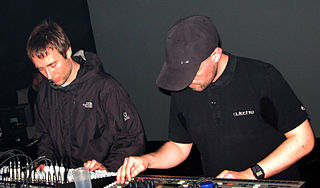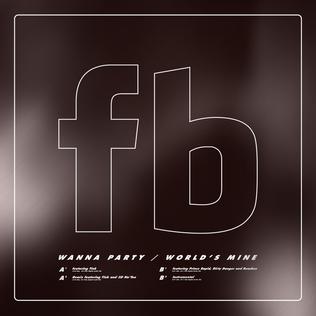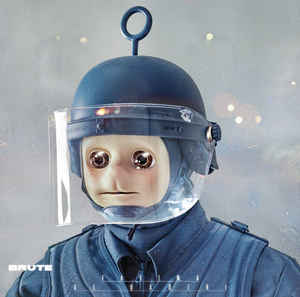Intelligent dance music (IDM) is a style of electronic music originating in the early 1990s, defined by idiosyncratic experimentation rather than specific genre constraints. The music often described with the term originally emerged in the early 1990s from the culture and sound palette of styles of electronic dance music such as acid house, ambient techno, Detroit techno and breakbeat; it has been regarded as better suited to home listening than dancing. Prominent artists in the style include Aphex Twin, Autechre, Squarepusher, μ-Ziq, the Black Dog and the later duo Plaid, as well as earlier acts such as the Future Sound of London and Orbital.

Autechre are an English electronic music duo consisting of Rob Brown and Sean Booth, both from Rochdale, Greater Manchester. Formed in 1987, they are among the best known acts signed to UK electronic label Warp Records, through which all of Autechre's full-length albums have been released beginning with their 1993 debut Incunabula. They gained initial recognition when they were featured on Warp's 1992 compilation Artificial Intelligence.

Warp Records is a British independent record label founded in Sheffield in 1989 by record store employees Steve Beckett and Rob Mitchell and record producer Robert Gordon. It is currently based in London.

Simple Plan is a Canadian rock band from Montreal, Quebec. Formed in 1999, the band's current lineup consists of Pierre Bouvier, Chuck Comeau (drums), Jeff Stinco, and Sébastien Lefebvre. David Desrosiers joined the band in early 2000 and left in July 2020.
Stephen James Wilkinson, better known as Bibio, is an English musician and producer. He is known for a distinct analog lo-fi sound, and for working in a diverse range of genres, beginning in folktronica and ambient and later stretching to include instrumental hip hop, indie pop, electronica, soul, funk, and alternative R&B.

Richard David James, known professionally as Aphex Twin, is a British musician, record producer, composer and DJ. He is known for his idiosyncratic work in electronic styles such as techno, ambient and jungle. Journalists from publications including Mixmag, The New York Times, NME, Fact,Clash and The Guardian have called James one of the most influential and important artists in contemporary electronic music.

Daniel Lopatin, best known as Oneohtrix Point Never or OPN, is an American experimental electronic music producer, composer, singer, and songwriter. His music has utilized tropes from various musical genres and eras, sample-based composition, and complex MIDI production.

LuckyMe is a United Kingdom–based record label and design studio specialising in the release of new electronic, hip hop, pop, rock and underground dance music. Referred to as "one of the most innovative and prolific independent record labels of the decade" and acclaimed for "distinctive visual arts projects and collaborations".

Rustie is a Scottish musician from Glasgow. He is associated with the Numbers label collective and first received attention for his 2007 EP Jagz the Smack. He signed to Warp Records in 2009. His 2011 debut album Glass Swords won him widespread acclaim. His music blends disparate genres, including hip hop, rave, and electronic trap.
Future Brown are a production group formed of Fatima Al Qadiri, J-Cush, Asma Maroof and Daniel Pineda.

Nobody is a collaborative studio album by American hip hop recording artist Chief Keef and record producer 12Hunna. It was independently released on December 16, 2014, by Keef's Glo Gang label. The album is primarily a solo effort, includes two guest features from Tadoe and Kanye West. The album's production and lyrics are representative of the drill music genre.

Wanna Party / World's Mine is a 2014 EP by Future Brown, released on Warp Records.

Trinity Laure'Ale Home , better known by her stage name Tink, is an American rapper and R&B singer from Chicago, Illinois. She signed with record producer Timbaland's Mosley Music Group, an imprint of Epic Records to release her 2014 debut single, "Treat Me Like Somebody". Her 2015 single, "Million", entered the Bubbling Under Hot 100. Both produced by Timbaland, the songs were intended to precede her debut studio album Think Tink, although disagreements with the producer led her to part ways with the label in 2017.
Fatima Al Qadiri is a Senegalese-born Kuwaiti musician and conceptual artist.

Hallucinogen is the debut extended play (EP) by American singer and songwriter Kelela. It was released on October 9, 2015, by Warp Records and Cherry Coffee Music.

Brute is the second studio album of Kuwait musician Fatima Al Qadiri. A protest album inspired by events such as the 2015 Baltimore protests and the Ferguson unrest, the album regards the authoritarian power of law enforcement in the United States and the illusion of democracy existing in the western part of the world. Its cover art by Josh Kline, Babok Radboy, and Joerg Lohse is a photograph of one of the "police teletubbies" found in Kline's art piece "Freedom," which was intended to present how civil rights were being destroyed in the 21st century. Brute features samples of the Ferguson protest, an MSNBC report of Occupy Wall Street by Lawrence O'Donnell, and an interview with a former member of the LAPD regarding the power of the police.

Warn-U is the debut extended play of Kuwait musician Fatima Al Qadiri, released in September 2011 by the label Tri Angle. It was a part of her project Ayshay, which intended to reinterpret Islamic worship music. The EP only consists of Qadiri's falsetto vocals that are processed and altered to create other types of electronic sounds. The EP consists of three original tracks and a "megamix" of all of them by production duo Nguzunguzu.

Genre-Specific Xperience is a project by Kuwait musician Fatima Al Qadiri that serves as her second extended play in her discography. Its intention is to reinterpret five musical genres through audio and visuals: juke, hip hop, dubstep, electronic tropicalia, and what the press release labeled as "‘90s Gregorian trance." The main idea of the project regards what would happen if the "limitations" of a genre were bypassed or altered. The visuals for the tracks were produced by Tabor Robak, Sophia Al-Maria, Ryan Trecartin, Rhett LaRue, Kamau Patton, and production company Thunder Horse. The music videos premiered at New Museum on 21 October 2011, and the extended play itself was released by UNO Records on 25 October to favorable reviews from professional music journalists. A remix record titled GSX Remixes was released in May 2012 and features re-edits of tracks from Genre-Specific Xperience by acts such as Ikonika and DJ Rashad.

Asiatisch is the debut full-length studio album of Kuwaiti musician Fatima Al Qadiri, released by the label Hyperdub on 5 May 2014. The record is about what Qadiri called "Imagined China," an environment of stereotypes about East Asian nations and respective cultures formed in media of the Western world. Thus, it musically derives from sinogrime, a style of grime music that utilizes elements of East Asian music. In representing Asian stereotypes, the album includes digital traditional Chinese and Japanese-styled drum kits and synth presets alongside "scrambled" ancient Chinese poems. One of the main inspirations for Qadiri producing Asiatisch was the making of a "nonsense Mandarin" a cappella version of the song "Nothing Compares 2 U" that would later be the record's opening track.
"Drake Would Love Me" is an R&B song recorded by American singer K. Michelle for her second studio album, Anybody Wanna Buy a Heart? (2014). It was written by Michelle and Bianca Atterberry. Its music and production came from Oak Felder, Ronald "Flippa" Colson, and Stephen Mostyn. Atlantic Records initially released the song via streaming on VH1's website on December 2, 2014, before it became available with the rest of the album the following week.















